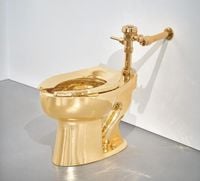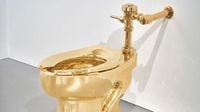In a move that's set the art world abuzz, Sotheby’s announced on October 31, 2025, that it will auction off one of the most talked-about sculptures of the 21st century: an 18-karat solid gold toilet by Italian conceptual artist Maurizio Cattelan, aptly titled "America." The auction, scheduled for November 18 at Sotheby’s new Breuer Building headquarters in New York, will feature a starting bid pegged to the fluctuating price of gold—currently about $10 million, thanks to the sculpture's more than 101 kilograms (223 pounds) of precious metal. But the true story of "America" is far richer than its material worth alone.
First unveiled at the Guggenheim Museum in New York in 2016, "America" immediately captured the public’s imagination. Over a year-long exhibition, more than 100,000 visitors queued up for a chance to experience what the Guggenheim described as "unprecedented intimacy with a work of art." The toilet was not merely on display—it was plumbed in and fully functional, allowing museum-goers to, quite literally, interact with art in the most personal way possible.
David Galperin, Sotheby’s Head of Contemporary Art in New York, described the piece as “Cattelan’s tour de force,” explaining in an interview with Observer that "Holding both a proverbial and literal mirror to the art world, the work confronts the most uncomfortable questions about art, and the belief systems held sacred to the institutions of the market and the museum." It’s a sentiment echoed by the artist himself. Cattelan has said, “Whatever you eat, a $200 lunch or a $2 hot dog, the results are the same, toilet-wise.” The humor is biting, but the point is clear: "America" satirizes the intersection of excessive wealth, art, and value—both cultural and material.
But the story of "America" took a dramatic turn in 2019 when a version of the golden toilet was installed at Blenheim Palace in England, the birthplace of Winston Churchill. In a brazen five-minute heist, thieves broke into the UNESCO World Heritage site, ripped the toilet from its plumbing, and vanished. The theft caused significant structural damage and flooding at the palace and made headlines around the globe. Although three British men were convicted for their roles in the crime earlier this year, the sculpture itself was never recovered. Authorities believe it was likely broken up and melted down for its gold, which was insured for £4.8 million.
This theft only amplified "America’s" notoriety. As ARTnews reported, the saga has become "an object of torment for arts publicists and their lofty press statements," and the toilet’s disappearance has, perhaps ironically, cemented its place in art history. Sotheby’s now describes the edition going to auction as possibly the only physical one in existence, since another edition is believed not to have been fabricated, and the stolen version is presumed destroyed.
The upcoming auction marks a rare opportunity for the public to see "America" once again. Starting November 8, Sotheby’s will install the sculpture in a bathroom at its Breuer Building headquarters for a ten-day preview. But unlike previous exhibitions, visitors can only look—they won’t be able to use the toilet. Galperin joked to CNN, “The door will remain open,” but security (and perhaps common sense) dictates a strictly no-flush policy this time around.
Why all the fuss over a golden toilet? The answer lies in Cattelan’s conceptual genius and his knack for poking fun at the art world’s conventions. The work draws a direct line to Marcel Duchamp’s 1917 "Fountain," the infamous porcelain urinal signed "R. Mutt" that upended traditional notions of what qualifies as art. As Galperin noted, "Cattelan revisits the original provocation of Duchamp’s gesture, but turns it further on its head. Whereas Duchamp took a readymade object and elevated it to the status of art through contextualizing it as an artwork, Cattelan re-creates the readymade entirely, fashioning an exact functioning replica out of gold."
But Cattelan’s critique doesn’t stop at art theory. “America” also lampoons the mechanisms by which value is assigned in both the art market and society at large. As Observer highlighted, the work “continues Cattelan’s conceptual exploration of artistic production and the mechanisms by which value is ascribed.” It’s a perfect foil to Cattelan’s other headline-grabbing piece, "Comedian"—the banana duct-taped to a wall that sold at Sotheby’s for $6.2 million last year. While "Comedian" was all about the intangibility of value, "America" is intrinsically valuable—its worth as gold is undeniable, even before considering its status as art.
In a sign of the times, Sotheby’s will accept cryptocurrency for the auction, a nod to the growing influence of digital assets in the art world. Galperin told ARTnews the house expects interest from "seasoned, established collectors of contemporary art, as [much as] new ones, that includes those collectors who are active in the crypto community." This echoes last year’s sale of "Comedian," which was purchased by crypto billionaire Justin Sun, who famously ate the banana after buying it.
The timing of the auction is also notable. According to the World Gold Council, gold demand rose 3% year-over-year in Q3 2025 to a record 1,313 metric tons, making gold-based art an even more attractive investment. As Observer put it, "Maurizio Cattelan’s toilet [is] a doubly secure asset that stores value both in the 'brand' of one of the most recognizable artists of our time and in the precious material of the work itself."
For Cattelan, whose auction record stands at $17.2 million for the controversial sculpture "Him"—a wax and human-hair statue of Adolf Hitler—the sale of "America" could set a new benchmark. But beyond the dollars and headlines, the work’s enduring legacy may be its ability to force viewers, collectors, and critics alike to confront uncomfortable questions about art, value, and society. As Galperin summed up, “Cattelan, for his entire career, has critiqued the system—whether it’s the viewers’ experience seeing art in a museum, the way that works of art move through the system, the way that they’re valued, the way that they change hands. All of these concepts are things that artworks so rarely confront head on.”
So as "America" prepares to take center stage at Sotheby’s this November, it offers not just a glittering spectacle, but a mirror—reflecting the complexities, contradictions, and, yes, absurdities of the art world and beyond.


